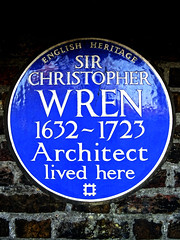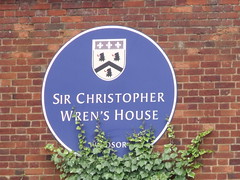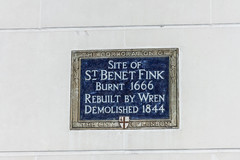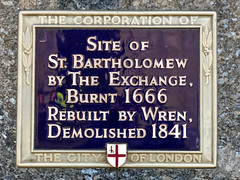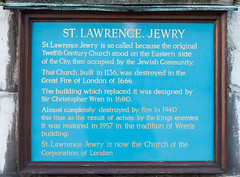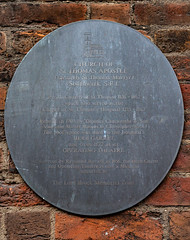Sir Christopher Wren PRS


Sir Christopher Wren PRS
(1632-1723)
architect, Knight Bachelor (from 1673), and 3rd President of the Royal Society (1680-1682)
Commemorated on 12 plaques
Sir Christopher Wren 1632-1723 architect lived here
The Old Court House, Hampton Court Green, East Molesey Richmond Upon Thames, London, United Kingdom where they lived
This house was designed and lived in by Sir Christopher Wren
Thames Street, Windsor, United Kingdom where they was allegedly
Site of St. Benet Fink burnt 1666 rebuilt by Wren demolished 1844
1 Threadneedle Street, EC2R, London, United Kingdom where they rebuilt
Here Lived Sir Christopher Wren during the building of St Pauls Cathedral Here also, in 1502, Catherine, Infanta of Castille and Aragon, afterwards first Queen of Henry VIII, took shelter on her first landing in London
Blackfriars Road, London, United Kingdom where they lived
Site of St. Bartholomew by The Exchange, Burnt 1666 rebuilt by Wren, Demolished 1841
Threadneedle St, London, United Kingdom where they rebuilt
This building, reputed to be from designs by Sir Christopher Wren, was erected as a church by Lord Hatton to serve the needs of the neighbourhood after St. Andrew's Holborn had been destroyed in the Great Fire of 1666. It was adapted for use as a charity school about 1696, was severely damaged by incendiary bombs during the 1939-45 war and has since been reconstructed internally to provide offices - the original facades being restored and retained. The figures of scholars in 18th century costume taken down and sent for safe keeping during the war to Bradfield College, Berkshire have been replaced in their original positions as a memorial of the former use of the building.
43 Hatton Garden, Holborn, London, United Kingdom where they reputedly designed
The church of St Dunstan in the East stood on this site from ancient times. Sir Christopher Wren rebuilt the church after the Great Fire of 1666 and the only part of his design which survivies is the tower. The remainder of the church was rebuilt in 1817 and destroyed by enemy action in 1941. This garden was created by the Corporation of London and opened by the RT. Hon. The Lord Mayor Sir Peter Studd. on 21st June 1971.
St Dunstan in the East, London, United Kingdom where they rebuilt
St Lawrence Jewry is so called because the original Twelfth Century Church stood on the Eastern side of the City, then occupied by the Jewish Community. That Church, built in 1136, was destroyed in the Great Fire of London of 1666 The building which replaced it was designed by Sir Christopher Wren in 1680. Almost completely destroyed by fire in 1940 this time as the result of action by the King's enemies it was restored in 1957 in the tradition of Wren's building. St. Lawrence Jewry is now the Church of the Corporation of London
Guildhall Yard, London, United Kingdom where they was
The Guild Church of St Mary Aldermary Rebuilt 1679-82 by Wren's office after the Great Fire of London The interior is enriched with splendid plaster fan vaulted ceilings The plan of the church follows its medieval outline
69 Watling Street, London, United Kingdom where they was
The Monument, was designed by Robert Hooke FRS in consultation with Sir Christopher Wren, was built 1671-1677, on the site of St Margaret Fish Street Hill. To commemorate the Great Fire of London 1666. the fire burnt from 2 to 5 September, devastating two-thirds of the city, and destroying 13,200 houses, 87 churches, and 52 Livery Company Halls. The Monument, a freestanding fluted Doric column topped by a flaming copper urn, is 61m/202ft in height, being equal to the distance westward from the site of the bakery in Puddin Lane where the fire first broke out. It's central shaft originally housed lenses for a zenith telescope, and its balcony, reached by an internal spiral staircase of 311 steps, affords panoramic views of the city. The allegorical sculpture on the pedestal above was executed by Caius Gabriel Cibber and shows Charles II coming to assist the slumped figure of the City of London. St Magnus the Martyr Fish Hill Street, ot the south, leads to St Magnus the Martyr, a Wren church, alongside which is the ancient street which led to the medieval London Bridge
Fish Hill Street, London, United Kingdom where they was
Church of St Thomas Apostle (formerly St Thomas Martyr) Southwark, SE1 Parish Church of St Thomas 1136-1862 which also served as the Chapel of St. Thomas's Hospital 1215-1862 Rebuilt in 1703 by Thomas Cartwright & Son (Sometime Master Mason to Christopher Wren) The roof space was used as the hospital's Herb Garret and from 1822 as its Operating Theatre Rediscovered by Raymond Russell in 1956, the Herb Garret and Operating Theatre is now a Museum
St Thomas Street, London, United Kingdom where they was
Some Facts of Interest in the History of the Old Church The Church was built to replace the former Church of St John at Tyburn 1400 Francis Bacon was married here 1606 William Hogarth portrayed the interior of the Church 1735 James Gibbs Architect, pupil of Wren was buried here 1754 Richard Brinsley Sheridan married Miss Linley here 1773 Charles Wesley brother of John Wesley was buried here 1788 Lord Byron was baptized here 1788 Lord Nelson worshipped here and Horatia his only child was baptized here 1803
Garden of Rest, Marylebone High Street, London, United Kingdom where they designed

